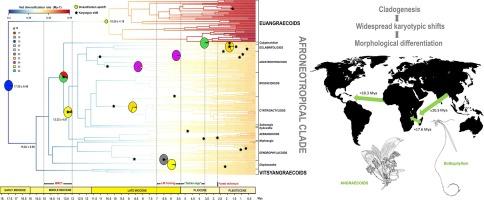A groundbreaking study published in Frontiers reveals that rapid radiations – swift bursts of evolutionary diversification – have been the driving force behind the vast majority of life’s known diversity. Challenging traditional views of gradual evolutionary change, this new research sheds light on how quick, explosive events in the history of life have generated the rich tapestry of species we see today. Scientists say these findings not only deepen our understanding of evolution’s pace but also have significant implications for conservation and the study of biodiversity hotspots around the world.
Breakthrough Research Reveals Rapid Radiations as Key Drivers of Life’s Diversity
Recent studies have uncovered that the vast majority of Earth’s biodiversity emerged through episodes of rapid evolutionary radiations. These bursts of diversification occur when species rapidly branch out from a common ancestor, often in response to environmental shifts or new ecological opportunities. Such radiations are now considered the primary engine driving the extraordinary variety of life forms observed today. By accelerating adaptation and speciation processes, rapid radiations have shaped major clades across the tree of life, from plants to vertebrates, fueling ecosystems with novel traits and complex interactions.
- Key factors: environmental change, genetic innovation, ecological niches
- Examples: Darwin’s finches, cichlid fishes, flowering plants
- Impact: increased resilience and adaptability of ecosystems
| Group | Radiation Period | Species Diversified |
|---|---|---|
| Cichlid Fishes | Last 10 million years | Over 1,500 |
| Flowering Plants | Early Cretaceous (140 mya) | 250,000+ |
| Birds | Post-dinosaur extinction (66 mya) | 10,000+ |
The findings challenge conventional views that depicted diversification as a slow and steady process, highlighting instead punctuated bursts of evolutionary activity that respond dynamically to the planet’s changing conditions. Scientists are now leveraging this knowledge to predict how current global changes might trigger similar radiations-or extinctions-offering vital insights for conservation strategies. Ultimately, embracing the role of rapid radiations deepens our understanding of life’s adaptability and unravels the mysteries behind the ever-expanding tree of life.
Unraveling the Evolutionary Bursts Shaping Our Planet’s Biodiversity
Throughout Earth’s history, biodiversity has not accumulated at a steady pace. Instead, life has experienced periods of explosive diversification often referred to as evolutionary bursts. These rapid radiations have given rise to the vast array of species we observe today, from the towering trees in ancient forests to the myriad insects populating every ecosystem. Scientists now view these bursts as critical turning points, where environmental shifts, genetic innovations, or ecological opportunities catalyzed the rapid emergence of new lineages. By unraveling these patterns, researchers are gaining unprecedented insights into how complexity evolved so swiftly and why some groups of organisms dominate the biosphere while others remain relatively scarce.
Recent studies highlight key factors associated with these diversification surges:
- Mass extinctions: Clearing ecological niches and paving the way for new species to flourish.
- Genomic innovations: Such as gene duplications and regulatory network rewiring that enable novel traits.
- Geographic fragmentation: Driving isolated populations to evolve independently and rapidly.
| Evolutionary Burst Event | Approximate Age (Mya) | Notable Outcome |
|---|---|---|
| Cambrian Explosion | ~541 | Rapid emergence of most major animal phyla |
| Post-Permian Extinction | ~252 | Diversification of modern vertebrates |
| Cenozoic Mammalian Radiation | ~66 | Rise of mammals after dinosaur extinction |
Experts Call for Enhanced Focus on Rapid Radiations to Inform Conservation Strategies
Scientists emphasize that rapidly radiating lineages represent evolutionary hotspots generating a substantial portion of the planet’s biodiversity. These bursts of speciation, often triggered by environmental changes or key innovations, result in clusters of closely related species that can adapt swiftly to diverse habitats. Understanding the mechanisms and outcomes of rapid radiations is crucial for identifying species and ecosystems most vulnerable to ongoing environmental pressures, including climate change and habitat fragmentation.
The complexity of rapid radiations demands integrative approaches combining genomics, ecology, and paleobiology. Experts urge conservationists to incorporate this dynamic perspective by:
- Prioritizing genetic diversity linked to recent evolutionary events
- Recognizing the ecological roles of rapidly diversified groups
- Designing management plans that accommodate evolutionary potential
| Key Aspect | Conservation Implication |
|---|---|
| Speciation Speed | Targets dynamic populations for monitoring |
| Ecological Adaptability | Supports resilience assessments |
| Genetic Novelty | Guides protection of unique traits |
The Way Forward
As research continues to unravel the intricate patterns of life’s evolution, the role of rapid radiations emerges as a powerful force shaping the vast biodiversity we see today. This deeper understanding not only challenges longstanding assumptions but also highlights the dynamic processes that have driven life’s explosive diversification across the globe. With these findings published in Frontiers, scientists are better equipped to explore evolutionary histories and preserve the rich tapestry of species that constitute our planet’s natural heritage.































